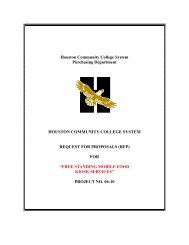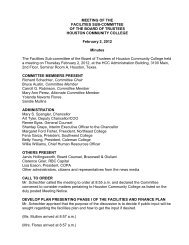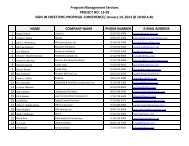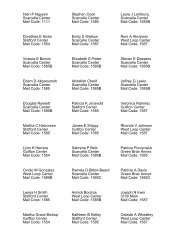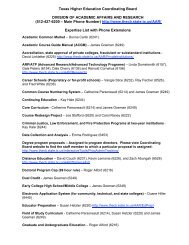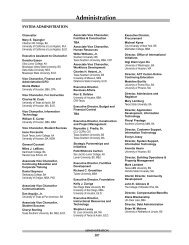General Course Descriptions - Houston Community College System
General Course Descriptions - Houston Community College System
General Course Descriptions - Houston Community College System
Create successful ePaper yourself
Turn your PDF publications into a flip-book with our unique Google optimized e-Paper software.
CHeF 2336 CHArCuterie<br />
Credit: 3 (2 lecture, 4 lab)<br />
Advanced concepts in the construction of sausages,<br />
pates, and related forced meat preparations .<br />
CHeM 1305 introduCtory<br />
CHeMistry i<br />
prerequisites: Must be placed into gust<br />
0342 (or higher) in reading and engl<br />
0310/0349 (or higher) in writing.<br />
Credit: 3 (3 lecture)<br />
<strong>General</strong> introduction to fundamental principles<br />
of chemistry includes atomic structure, chemical<br />
formulas, molecules, reactions, and elementary<br />
thermodynamics . This course is intended to be<br />
preparatory to CHEM 1411 for science majors who<br />
have no prior knowledge of chemistry . Core Curriculum<br />
<strong>Course</strong> . Note: Only one of CHEM 1305, CHEM 1405,<br />
and/or CHEM 1411 can be used toward associate<br />
degree natural science requirements . Only one of the<br />
three will count as Natural Science core; the others<br />
may count as electives in the degree plan .<br />
CHeM 1307 introduCtory<br />
CHeMistry ii<br />
prerequisite: CHeM 1305, Must be placed<br />
into gust 0342 (or higher) in reading and<br />
engl 0310/0349 (or higher) in writing.<br />
Credit: 3 (3 lecture)<br />
Continuation of CHEM 1305 . The organic chemistry<br />
of aliphatic and aromatic hydrocarbons, oxygen<br />
and nitrogen-containing organic compounds, and<br />
biochemistry is introduced . Core Curriculum <strong>Course</strong> .<br />
Note: Only one of CHEM 1307, CHEM 1407, and/or<br />
CHEM 1412 can be used toward associate degree<br />
natural science requirements . Only one of the three<br />
will count as Natural Science core; the others may<br />
count as electives in the degree plan .<br />
CHeM 1405 introduCtory<br />
CHeMistry i<br />
prerequisites: Must be placed into gust<br />
0342 (or higher) in reading and engl<br />
0310/0349 (or higher) in writing.<br />
Credit: 4 (3 lecture, 3 lab)<br />
A general introduction to the properties of matter .<br />
Topics include atomic structure, energy, chemical<br />
bonding, reactions, gas laws and elementary<br />
thermodynamics . This is a preparatory course to<br />
CHEM 1411 for science majors who have no prior<br />
knowledge of chemistry . Core Curriculum <strong>Course</strong> .<br />
Note: Only one of CHEM 1305, CHEM 1405, and/or<br />
CHEM 1411 can be used toward associate degree<br />
natural science requirements . Only one of the three<br />
will count as Natural Science core; the others may<br />
count as electives in the degree plan .<br />
CHeM 1407 introduCtory<br />
CHeMistry ii<br />
prerequisite: CHeM 1405; Must be placed<br />
into gust 0342 (or higher) in reading and<br />
engl 0310/0349 (or higher) in writing.<br />
Credit: 4 (3 lecture, 1 lab)<br />
Continuation of CHEM 1405 . The chemistry of<br />
carbon compounds . Topics include aliphatic and<br />
aromatic hydrocarbons, alcohols, ethers, aldehydes,<br />
ketones, carbolic acids, acid derivatives, amines and<br />
biochemistry is introduced . Core Curriculum <strong>Course</strong> .<br />
Note: Only one of CHEM 1307, CHEM 1407, and/or<br />
CHEM 1412 can be used toward associate degree<br />
natural science requirements . Only one of the three<br />
will count as Natural Science core; the others may<br />
count as electives in the degree plan .<br />
CHeM 1411 generAl CHeMistry i<br />
prerequisites: one year of high school<br />
Chemistry; Must be placed into collegelevel<br />
reading (or take gust 0342 as a corequisite)<br />
and be placed into MAtH 0312<br />
(or higher) and be placed into college-level<br />
writing (or take engl 0310/0349 as a<br />
co-requisite).<br />
Credit: 4 (3 lecture, 3 lab)<br />
Science and engineering majors study atomic<br />
structure, chemical reactions, thermodynamics,<br />
electronic configuration, chemical bonding, molecular<br />
structure, gases, states of matter, and properties of<br />
solutions . Core Curriculum <strong>Course</strong> . Note: Only one<br />
of CHEM 1305, CHEM 1405, and/or CHEM 1411 can<br />
be used toward associate degree natural science<br />
requirements . Only one of the three will count as<br />
Natural Science core; the others may count as<br />
electives in the degree plan .<br />
CHeM 1412 generAl CHeMistry ii<br />
prerequisite: CHeM 1411; ; Must be placed<br />
into college-level reading (or take gust<br />
0342 as a co-requisite) and be placed into<br />
MAtH 0312 (or higher) and be placed<br />
into college-level writing (or take engl<br />
0310/0349 as a co-requisite).<br />
Credit: 4 (3 lecture, 3 lab)<br />
Continuation of CHEM 1411 . Topics include solutions,<br />
chemical kinetics, equilibrium and equilibrium<br />
phenomena in aqueous solution, acids and bases, pH,<br />
thermodynamics, electrochemistry, nuclear chemistry,<br />
organic chemistry, and biochemistry . Core Curriculum<br />
<strong>Course</strong> . Note: Only one of CHEM 1307, CHEM 1407,<br />
and/or CHEM 1412 can be used toward associate<br />
degree natural science requirements . Only one of the<br />
three will count as Natural Science core; the others<br />
may count as electives in the degree plan .<br />
CHeM 1413 <strong>College</strong> CHeMistry i<br />
prerequisite: Must be placed into collegelevel<br />
reading (or take gust 0342 as a corequisite)<br />
and be placed into MAtH 0312<br />
(or higher) and be placed into college-level<br />
writing (or take engl 0310/0349 as a<br />
co-requisite).<br />
Credit: 4 (3 lecture, 3 lab)<br />
Nursing and allied health science majors study<br />
atomic structure, electron configuration, periodic<br />
law, radioactivity and its effects on living organisms,<br />
chemical bonding, molecules, gases, solutions,<br />
solution concentration, acids and bases, and buffers .<br />
Core Curriculum <strong>Course</strong> .<br />
CHeM 1414 <strong>College</strong> CHeMistry ii<br />
prerequisite: CHeM 1413, Must be placed<br />
into college-level reading (or take gust<br />
0342 as a co-requisite) and be placed into<br />
MAtH 0312 (or higher) and be placed<br />
into college-level writing (or take engl<br />
0310/0349 as a co-requisite).<br />
Credit: 4 (3 lecture, 3 lab)<br />
Continuation of CHEM 1413 . Topics include the<br />
organic chemistry of hydrocarbons, alcohols, ethers,<br />
aldehydes, ketones, carboxylic acids, esters, amines,<br />
and amides; biochemistry topics include amino acids<br />
and proteins, enzymes, carbohydrates, and lipids .<br />
Core Curriculum <strong>Course</strong> .<br />
<strong>Course</strong> desCriptions<br />
230<br />
CHeM 2423 orgAniC CHeMistry i<br />
prerequisite: CHeM 1412, Must be placed<br />
into college-level reading and be placed<br />
into MAtH 1314 (or higher) and be placed<br />
into college-level writing.<br />
Credit: 4 (3 lecture, 3 lab)<br />
Study of compounds of carbon . Topics include<br />
alkanes, alkenes, alkynes, alcohols, alkyl halides,<br />
stereochemistry, nucleophilic substitution, reaction<br />
mechanisms and synthesis . Core Curriculum <strong>Course</strong> .<br />
Study of the properties and behavior of hydrocarbon<br />
compounds and their derivatives . Designed for<br />
students in science or pre-professional programs .<br />
CHeM 2425 orgAniC CHeMistry ii<br />
prerequisite: CHeM 2423, Must be placed<br />
into college-level reading and be placed<br />
into MAtH 1314 (or higher) and be placed<br />
into college-level writing.<br />
Credit: 4 (3 lecture, 3 lab)<br />
Continuation of CHEM 2423 . Topics include aromaticity,<br />
benzene and EAS reactions, aldehydes, ketones,<br />
carboxyliacids and their derivatives, condensation<br />
reactions, amines, phenols, and infrared and NMR<br />
spectroscopy . Core Curriculum <strong>Course</strong> .<br />
CHeM 2427 pHysiologiCAl<br />
CHeMistry<br />
prerequisite: CHeM 1412, or CHeM 1414,<br />
Must be placed into college-level reading<br />
and be placed into MAtH 1314 (or higher)<br />
and be placed into college-level writing.<br />
Credit: 4 (3 lecture, 3 lab)<br />
Topics include polysaccharides, lipids, nucleic acids,<br />
proteins, catalysis reactions in living cells, intermediate<br />
metabolism, energy pathways in cells, DNA replication,<br />
and protein synthesis . Core Curriculum <strong>Course</strong> .<br />
CHHs 1311 CoMMerCiAl<br />
HouseKeeping/MAintenAnCe<br />
Credit: 3 (3 lecture)<br />
An introduction to commercial housekeeping and<br />
related maintenance and preventative maintenance<br />
planning and procedures . Emphasis on work rules,<br />
safety rules, and proper care of equipment . An<br />
overview of the chemistry of cleaning and proper<br />
handling of hazardous chemicals . An introduction<br />
to Occupational Safety and Health Administration<br />
(OSHA) requirements and designing a communications<br />
program . Choosing the proper floor care system and<br />
procedures for resilient tile are included .<br />
CHin 1411 Beginning<br />
CHinese i<br />
prerequisites: Must be placed into gust<br />
0342 (or higher) in reading and engl<br />
0310/0349 (or higher) in writing.<br />
Credit: 4 (3 lecture, 2 lab)<br />
Introduction to Chinese language and culture .<br />
Development of basic skills in listening comprehension,<br />
speaking, reading, writing, and cultural awareness .<br />
<strong>Course</strong> includes vocabulary building, conversation<br />
and grammar . Transfers as foreign language credit .<br />
Core Curriculum <strong>Course</strong> .



